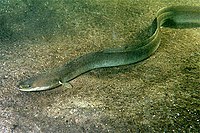
Photo from wikipedia
This study aims to characterize and compare the feeding ecology of the European eels (Anguilla anguilla L.) during the continental phase (i.e. yellow and silver) along a salinity gradient (i.e.… Click to show full abstract
This study aims to characterize and compare the feeding ecology of the European eels (Anguilla anguilla L.) during the continental phase (i.e. yellow and silver) along a salinity gradient (i.e. lower, middle and upper) in six northern France estuaries (i.e. brackish water). The diet and stable isotopic (i.e. δ15N and δ13C values) compositions of eels collected with a fyke net in six estuaries (Slack, Wimereux, Liane, Canche, Authie and Somme estuaries) located along the French coast of the eastern English Channel per season over a year were described by combining gut content and stable isotope analyses. Eel guts were dominated by typical BW prey, Malacostraca and Actinopterygii (54% and 40%, respectively), with the gammare Gammarus zaddachi and the green crab Carcinus maenas (38% and 14%, respectively), and smaller yellow eels of A. anguilla and juvenile European flounder, Platichthys flesus (19% and 14%, respectively) being the most frequently found in their guts. The δ13C values of a majority of eels confirmed the sea- and brackish water-specific carbon resources. Dietary and isotopic niche revealed no clear change between total length, silvering stages and seasons, but a significant difference between salinity gradients and estuaries. Eels δ13C values showed significant enrichment from upper to lower along the estuaries while the δ15N values showed an inverse effect, with the lowest values in the lower part and highest in the upper part. Higher variability in δ13C values in larger estuaries suggested that eels feed on a wide range of food sources than in smaller estuaries. While eels in the smaller estuaries fed mainly on Actinopterygii prey, eels in the larger ones had a lower trophic level (i.e. δ15N values) and fed mainly on Malacostraca prey. This spatial difference in dietary and isotopic niche is discussed in relation to biological structure of eel and environmental variables.
Journal Title: PLoS ONE
Year Published: 2022
Link to full text (if available)
Share on Social Media: Sign Up to like & get
recommendations!